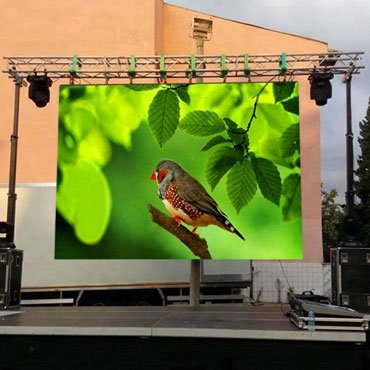We often hear abbreviations in English like HD, Full HD(FHD), Ultra HD(UHD), 4K, and so on, which can be overwhelming. Today, I’ll use a table to help you understand their relationships.
Comparison of HD, Full HD, Ultra HD, and 4K Data
| Definition | Image Resolution(W*H) | Pixel Density |
| HD | 1280 x 720 pixels | 0.92 megapixel |
| Full HD(FHD) | 1920 x 1080 pixels | 2.07 megapixels |
| Ultra HD(UHD) | 3840 x 2160 pixels | 8.3 megapixels |
| 4K | 4096 x 2160 pixels | 8.8 megapixels |
From the table, we can gather the following information:
- Image resolution (width * height) from low to high: HD (1280 x 720 pixels) < Full HD (1920 x 1080 pixels) < Ultra HD (3840 x 2160 pixels) < 4K (4096 x 2160 pixels).
- Clarity is determined by pixel density; the denser the pixels, the higher the quality, from low to high: HD (<1 megapixel) < Full HD (2.07 megapixels) < Ultra HD (8.3 megapixels) < 4K (8.8 megapixels).
- For the same image, the LED screen with higher resolution can display more image details.
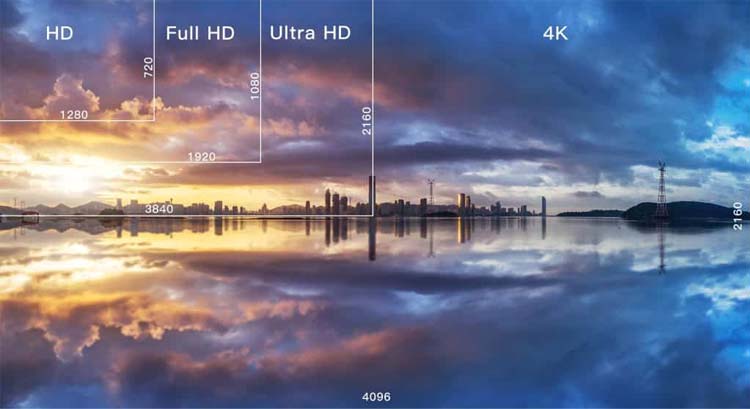
I don’t know if you have noticed that in LED display applications, prices vary greatly with different refresh rates. That’s because when we want to achieve different resolutions for the same model of LED display, the screen size will definitely be different.
The size of the LED display is one of the important factors that determine the price. The price difference between FHD LED displays and HD LED displays tends to cost 1,000-2,000 CNY per square meter and it is normal for 4K LED displays to even cost 7,000-80,00 CNY per square meter more than high-definition LED displays.
Why do LED display prices vary significantly with different resolutions?
We all know HD, Full HD, Ultra HD, 4K. These definition words are usually used to describe products such as LCD or OLED.
If we use them in some professional fields (such as monitoring rooms, virtual shooting, etc.), you will find that LED displays also use these definition words. When you look at the LED displays. And then you will also find that the prices of different refresh rate are very different. Why is this?
Let’s mention LCD first. From the summarized points above, we understand that LCD screen clarity is determined by pixel density. Therefore, increasing pixel density can easily achieve 4K or 8K quality, and the price range for different resolutions wouldn’t vary significantly.
However, the situation is entirely different with LED displays. The higher the quality of the LED display, the more expensive it is. The price difference between standard resolution and 4K resolution LED displays can even be several times.
For laymen unfamiliar with LED displays, this fact can be hard to accept. But don’t worry, I’ll help you unravel this mystery.
Firstly, we need to understand what determines the clarity of LED displays.
LED displays’ clarity is mainly determined by three parameters: refresh rate, screen size, and pixel pitch, among which pixel pitch and refresh rate are the most significant factors affecting LED display clarity.
About the optimal pixel pitch for the best viewing effect, you can refer to the introduction in the previous article:What is the Best Viewing Distance for LED? Here, we’ll introduce another crucial parameter—refresh rate.
Determinants of LED Display Refresh Rate
The refresh rate of LED displays is determined by three components: LED power supply, LED lamp bead, and LED ICs, among which the LED IC has the most significant impact on the screen’s refresh rate.
When using a standard IC, its maximum refresh rate can only reach 960Hz. However, using a double-latch IC can increase the refresh rate of the LED display to 1920Hz, commonly known as a high-refresh chip. Moreover, using high-definition advanced PWM ICs can make the refresh rate of LED displays exceed 3840Hz, known as ultra-high-refresh chips.
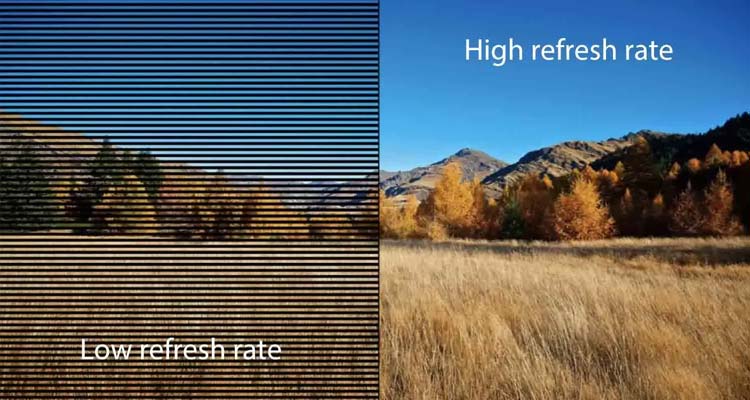
ICs with ultra-high refresh rates must use high-quality gold wire brackets, while those with high or standard refresh rates can choose copper or iron brackets. Therefore, in terms of production cost, there’s a significant difference between them.
LED display manufacturers will choose different grades of ICs according to the customer’s budget and then select LED ICs and LED power supplies that best match the current budget.
LED displays with standard refresh ICs can be made into high-definition LED displays. However, LED displays with Full HD, Ultra HD (also known as 2K ), or 4K resolutions require high-refresh ICs. Additionally, LED displays with higher resolutions require more accessories.
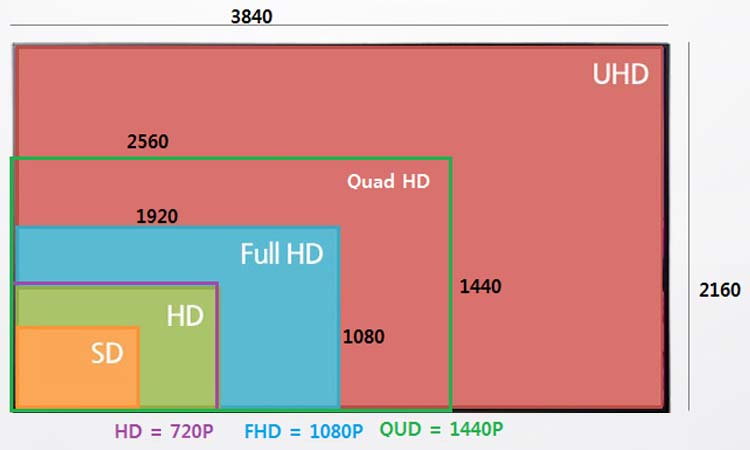
Generally, LED displays with standard refresh rates can be controlled by computers. But for Full HD, Ultra HD, or 4K displays, they need to be equipped with video processors to handle the screen. Moreover, depending on the screen size, there’s a maximum limit to the number of video processors that can be installed. Therefore, when the screen is particularly large, multiple video processors may need to be used simultaneously.
So, when you find the exact same model and size but with vastly different prices, you need to consider whether the materials used for the LED IC (standard refresh, high refresh, or ultra-high refresh) and LED ICs (gold wire bracket, copper bracket, or iron bracket), as well as LED power supplies (220V or 380V), are the same.
How to Choose Between Standard Refresh, High Refresh, and Ultra-High Refresh?
In general, unless otherwise specified, many LED display manufacturers default to using a standard refresh IC to manufacture LED displays. Due to the human eye’s persistence of vision, when the flicker frequency of a screen exceeds 24Hz, the human eye perceives a continuous motion.
Here’s a formula: Screen frame rate = Refresh rate / Video frame rate
For example, if a file with a refresh rate of 960Hz plays a video file with a frame rate of 30, the screen’s frame rate can reach 32Hz, exceeding the human eye’s perceptible 24Hz, resulting in a very clear image.
However, although the human eye cannot perceive the difference, cameras can. Under the camera’s shooting, LED displays with standard refresh ICs will produce obvious Moiré pattern, significantly reducing the photo’s quality.
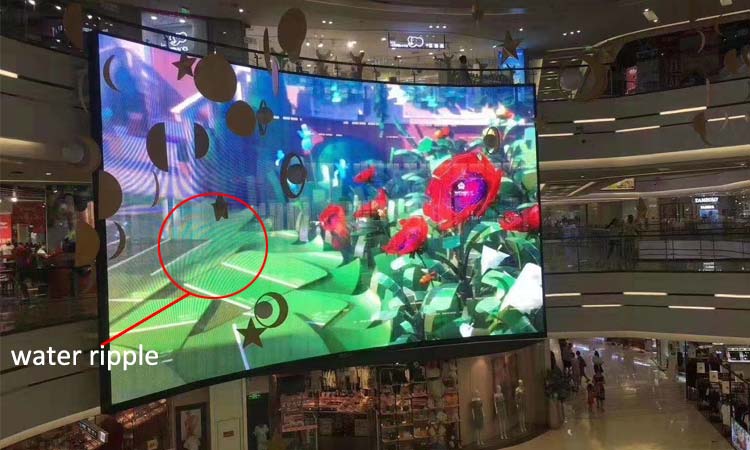
So, how should we choose between standard refresh, high refresh, and ultra-high refresh?
If we’re only in environments where photography requirements are not high, we can choose LED displays with standard refresh ICs, which are the most cost-effective.
For some places like tourist attractions, art galleries, aquariums, etc., which are meant to attract visitors to take photos, choosing LED displays with standard refresh rates will undoubtedly affect visitors’ moods due to the Moiré pattern in the images. In this case, we need to consider from the customer’s perspective and choose LED displays with high refresh rates to achieve the best shooting effect, thus attracting more people to the venue.
As for ultra-high refresh, it’s generally used in virtual shooting or immersive scenes. Virtual shooting uses high-speed capture cameras and requires ultra-high-refresh LED displays greater than 3840Hz to achieve the best results.




